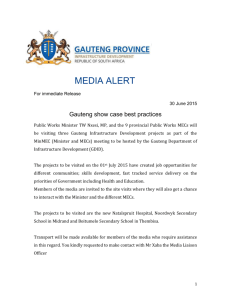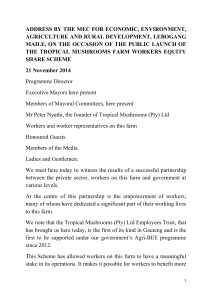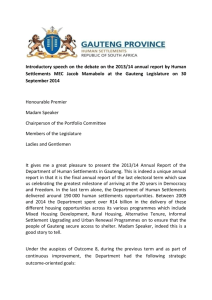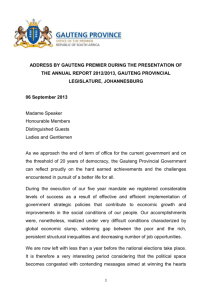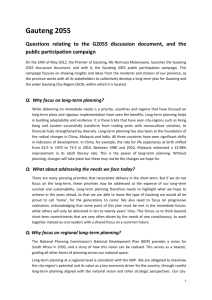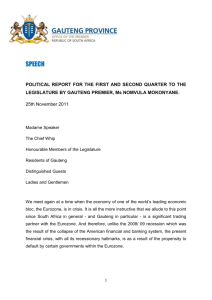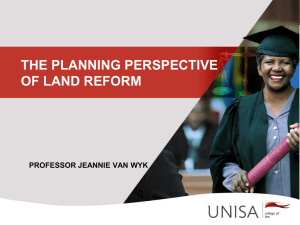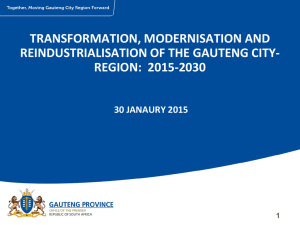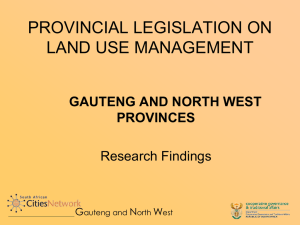Revisiting the Millennium Development Goals: How has the
advertisement
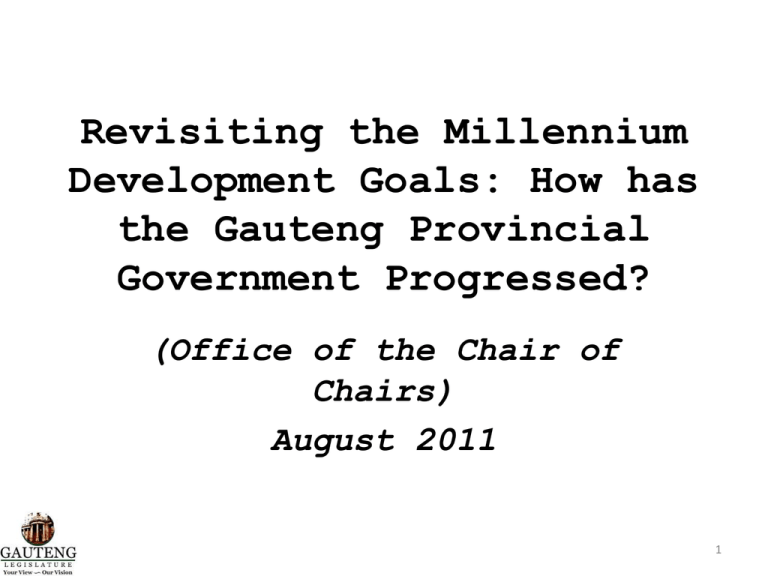
Revisiting the Millennium Development Goals: How has the Gauteng Provincial Government Progressed? (Office of the Chair of Chairs) August 2011 1 Introductory Remarks • Africa continues to face an increasing need to develop national security strategies to deal with the wide array of challenges resulting from the set goals, i.e. the Millennium Development Goals (MDGs). • Gauteng has not remained discarded of such challenges, yet strides (amid all vicissitudes) have been made towards achieving such. • Given the nature and dynamism attached to the MDG’s, this terse observation as highlighted in the following sections, calls for a development of what we henceforth refer to as trustworthy partnerships within the province and beyond. 2 Intro Remarks – (II) • Since gaining democracy in 1994, South Africa has undertaken a number of reforms (legislative, institutional and administrative). • This was and is done in order to form a favourable environment and improved quality of live for all the South Africans. • Gauteng Province as part of the South African Government is looking forward to achieve a developed and sustainable country. It is also committed to meet the set group of Millennium Development Goals (MGDs) that were agreed upon by a number of head of States during the summit in September 2000. 3 The Goals • Eradicate poverty and hunger • Achieve universal primary education • Promote gender equality and empower women • Reduce child mortality • Improve maternal health • Combat HIV/AIDS, Malaria and other diseases • Ensure environmental sustainability • Develop a global partnership for development 4 Review Purpose • To track the progress made thus far by the Gauteng Provincial Government (GPG) in relation to the achievement of the abovestated goals since September 2000 until to date. 5 Central Challenges: Literature and Approach • Considering the intensity of the study/review, the inadequacy of available information on the subject has provided limitations to the purpose of the exercise. However, not all goals are subjected to this observation. • Much of the observations are benchmarked on globally set-standards. However, obtainable capacity at home (either nationally or provincially) requires that domestically set standards be developed in order to enhance the strategic partnerships and alliances so as to ensure continuity at the trustworthy partnerships level (the only level that can be domesticated in its structure, course, and purpose). 6 Goal 1: Eradicating Poverty and Hunger • Gauteng is South Africa’s wealthiest province but it is still experiencing challenges of people living under poverty line. • The main target of this goal is to halve proportion of people who suffer from poverty and hunger by the year 2015 • Reports shows that the share of population living in poverty in Gauteng has declined from 29.6% in 2002 to 25.5% in 2008. 7 Goal 2: Achieve universal primary education • In terms of this goal every child should complete primary education • More importantly the aim of this strategy is to achieve gender equality • Poor performance in national and international assessments • Merely increasing enrolment rates is just not enough, there should also be an equal emphasis on excellence and quality. • Emphasize competency in numeracy, literacy and life-skills 8 Goal 3: Promote Gender Equality & Empower Women • Guided by the Convention on the Elimination of All Forms of Discrimination Against Women (CEDAW) and the Beijing Platform for Action, South Africa (in general) and Gauteng (in particular) endeavour to ensure that as a Constitutional imperative, gender equality is achieved. • The achievement of gender equality and women’s empowerment is supported by a framework of policies and mechanisms that include a national gender policy framework and the Department for Women, Children and Persons with Disabilities. 9 Goal 3: Promote Gender Equality & Empower Women – (II) Among the Programmes pursued by the GPG in enhancing women’s equitable involvement in the provincial government activities, the following are included: Quality Basic Education: • Increased education and skills development opportunities; • access and involvement of Women in Science, Technology and Engineering and Mathematics (STEM) Long and healthy life for all South Africans • Access to quality health care • Promotion of women’s health and the reproductive health rights for women • AU Decade for African Women 2010-2020 with 2011 focusing on Health, Maternal mortality and HIV&AIDS 10 Goal 3: Promote Gender Equality & Empower Women – (III) All people in South Africa are and feel safe • Elimination of Gender based violence including the rape and killing of lesbians • Launch of the Domestic Violence Forum • Awareness raising in issues of Human rights vs Gender Based Violence Decent Employment through inclusive economic growth • Job creation and employment opportunities with direct benefit for women • Economic empowerment for women • Economic transformation focused on women including access to business opportunities Vibrant, equitable, sustainable rural communities contributing towards food security for all • Access to agriculture and rural development opportunities for women 11 Goal 3: Promote Gender Equality & Empower Women – (IV) • Involvement of women in food security programmes Sustainable Human Settlements and improved Quality of household life • Access to basic services for women • Involvement of women in the construction field • Support for women owned household (indigents) and linking them to development programmes Responsive and accountable, effective and efficient local government system • Gender Mainstreaming and the empowerment of women in communities • Gender Institutional Mechanisms developed across municipalities An efficient, effective and development oriented public service; An empowered fair and inclusive citizenship • Social cohesion and the social participation of women • Promotion of Human Rights • Implementation of the Programme of action for gender equality and women empowerment 12 Goal 4 & 5: Reduce child/maternal mortality • Province working towards reducing child mortality by two thirds. • 163 death out 648 due to HIV/AIDS. However, govt introduced Protocol on HIV in pregnancy as an intervention • Decrease in deaths due to pregnancy. 13 Goal 6. Combating HIV and AIDS, Malaria, TB and other Diseases • Gauteng striving to ameliorate the effects of HIV/AIDS and other associated diseases. • The PMTC programme has to date resulted in women who are tested positive receiving Nevirapine. • A greater proportion of HIV/AIDS sufferers on anti-retroviral treatment. • The total number of patients on ART : 400 000 by 31st March 2011. • Number of women enrolled for ART while pregnant: 10 000 by 31 March 2011. • Number of children younger than one year on ART: 3 000 by March 20011 • Malaria under control with a decline of cases over a five year period. 14 Goal 7: Ensure Environmental Sustainability • The historical and recent Apartheid political regimes in South Africa played a major role in the entrenchment of environmental injustice and consequent quality of the social and biophysical environment. • The major influence on the spatial manifestation of environmental quality was racially segregated land ownership and use patterns, starting with the 1913 Land Act, which allocated 13 % of the land area of the country to the black 80 % of the population. • The result was overcrowded, poorly or un-serviced, unhealthy “townships” and “Bantustans”, perpetrating inequitable access to natural resources that persists to this day, notwithstanding attempts to address these issues. 15 Goal 7: Ensure Environmental Sustainability (II) • The economic and political climates in African and neighbouring SADC countries, most notably Nigeria, Zimbabwe and Mozambique, are resulting in an influx of refugees and immigrants seeking employment. • With the large concentrations of people in highly urbanised areas like Gauteng, this influx of foreigners is likely to severely aggravate the disparity between societal demand and the availability of resources. International trade and globalisation are seen to be inherently linked with the environment. • World Trade Organisation rules are held by many to be inimical to the interests of sound environmental management, due to the power of multi-national corporations to assert global economic imperatives over national statutes. 16 Goal 7: Some of the Mechanisms • The Gauteng Spatial Development Framework (SDF), local municipality SDFs, Spatial Development Initiatives (SDIs) and Environmental Management Frameworks (EMFs) are important factors influencing environmental change. • All SDFs are required to assess the environmental opportunities and constraints while EMFs aim to integrate social, economic and biophysical considerations in planning. • The Gauteng Integrated Energy Strategy – GPG Commits itself to: 17 Goal 7: GPG Commitments: a) moving the province to a low carbon economy; (b) ensuring that carbon emissions peak and start declining by 2030; (c) ensuring that there is improvement in the province’s record of energy efficiency; (d) ensuring that there is a scaling up of renewable energy options; and (e) ensuring that energy access the poor is made a priority. (See Gauteng Integrated Energy Strategy for further detail). 18 Goal 7: Energy Consumption & Sector Outlook • Roughly 50% of energy is used in the direct combustion of coal with the only other significant carriers being electricity and liquid fuels at around 20% each. • More than 90% of energy consumption in Gauteng is by the industrial and transport sectors at 58% and 34% respectively. This is quite different to the energy consumption pattern for the three Metros (Johannesburg, Ekurhuleni and Tshwane where industry accounts for 14% and transport for 60% of energy demand (47% of transport energy in the Metros is petrol, 28% diesel and 22% jet fuel. • The most important Provincial economic sectors are financial and business services, logistics and communications, and mining. The intention is for the Province’s economy to move away from traditional heavy industry markets and low value-added production towards sophisticated high value-added production, particularly in information technology, telecoms and other high-tech industries. • In an international survey in 2000, Gauteng was identified as one of 46 global hubs of technological innovation. The burgeoning hightech corridor in Midrand is the fastest developing area in the country. 19 Goal 7: Further Observations • In an international survey in 2000, Gauteng was identified as one of 46 global hubs of technological innovation. The burgeoning hightech corridor in Midrand is the fastest developing area in the country. • Furthermore, on July 15th 2011, the Gauteng Department of Agriculture and Rural Development in partnership with the University of Johannesburg launched a consultation Indaba that included stakeholders and developed a shared vision for the Durban Climate Change Conference to be held in December 2011. • Speakers ranged from departmental officials, academics, politicians and representatives from various organisations around Gauteng. • With no doubt, many countries around the world are vulnerable to natural disasters such as earthquakes and tsunamis. With Gauteng having experienced minor earthquakes in 2010, it leaves the province with no choice but to begin implementing tougher laws towards protecting our environment. 20 Goal 8: Develop a Global Partnership for Development • South Africa continues to be an active member in the international community. The various governance structures at a multilateral level remain channels through-which the achievement of the country’s foreign policy goals can be reached. • Gauteng’s role as a centre of attraction for migrant workers and foreign direct investments continues to grow. Strategic partnerships and alliances on various sector-related priorities shape the province’s agenda. • The goal of developing a global partnership for development sets out the target to be met by developed countries. They cover efforts in vital areas such as development aid, trade, debt relief, affordable essential drugs and foreign direct investments. 21 Goal 8: Develop a Global Partnership for Development • Harnessing aid targeted at various government and governance programmes will remain a determinant of the kind of development partnerships that the provinces seeks to forge • A bulk of social responsibility initiatives by various stakeholders becomes a key area through-which the provincial government can exercise its monitoring and evaluation function on the programmes it carries-out 22 Goal 8: Develop a Global Partnership for Development • The fact that the province plays host to a number of development agencies such as the Development Bank of South Africa, the China Development Bank, prestigious institutions of higher learning (where research and development is housed), various foreign missions in South Africa becomes an added advantage to the proximity of the kind quality interaction the province can achieve. • Most of the country’s development agencies are housed in the province. Numerous conferences on development are held in Gauteng. The economic and social development patterns of the province (the continent over) are exemplary to the management and strategic planning qualities that the political, business, and civil society organisations and leaders have in collaborating towards the achievement of the global partnership. • The vision of a New Partnership for Africa’s Development plays a major role in the Africanisation (i.e. the province’s Africacentred approach to development). 23


